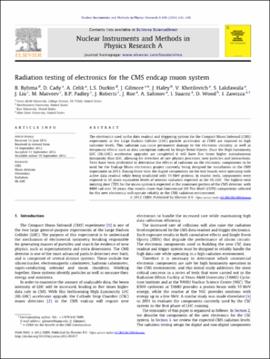| dc.contributor.author | Bylsma, B. | |
| dc.contributor.author | Cady, D. | |
| dc.contributor.author | Celik, A. | |
| dc.contributor.author | Durkin, L.S. | |
| dc.contributor.author | Gilmore, J. | |
| dc.contributor.author | Haley, J. | |
| dc.contributor.author | Khotilovich, V. | |
| dc.contributor.author | Lakdawala, S. | |
| dc.contributor.author | Liu, J. | |
| dc.contributor.author | Matveev, M. | |
| dc.contributor.author | Padley, B.P. | |
| dc.contributor.author | Roberts, J. | |
| dc.contributor.author | Roe, J. | |
| dc.contributor.author | Safonov, A. | |
| dc.contributor.author | Suarez, I. | |
| dc.contributor.author | Wood, D. | |
| dc.contributor.author | Zawisza, I. | |
| dc.date.accessioned | 2023-10-02T20:00:01Z | |
| dc.date.available | 2023-10-02T20:00:01Z | |
| dc.date.issued | 2012-09-18 | |
| dc.identifier | oksd_bylsma_radiation_testing_of_electronics_2012 | |
| dc.identifier.citation | Bylsma, B., Cady, D., Celik, A., Durkin, L.S., Gilmore, J., Haley, J., ... Wood, D., Zawisza, I. (2012). Radiation testing of electronics for the CMS endcap muon system. | |
| dc.identifier.uri | https://hdl.handle.net/11244/339628 | |
| dc.description.abstract | The electronics used in the data readout and triggering system for the Compact Muon Solenoid (CMS) experiment at the Large Hadron Collider (LHC) particle accelerator at CERN are exposed to high radiation levels. This radiation can cause permanent damage to the electronic circuitry, as well as temporary effects such as data corruption induced by Single Event Upsets. Once the High Luminosity LHC (HL-LHC) accelerator upgrades are completed it will have five times higher instantaneous luminosity than LHC, allowing for detection of rare physics processes, new particles and interactions. Tests have been performed to determine the effects of radiation on the electronic components to be used for the Endcap Muon electronics project currently being designed for installation in the CMS experiment in 2013. During these tests the digital components on the test boards were operating with active data readout while being irradiated with 55 MeV protons. In reactor tests, components were exposed to 30 years equivalent levels of neutron radiation expected at the HL-LHC. The highest total ionizing dose (TID) for the muon system is expected at the innermost portion of the CMS detector, with 8900 rad over 10 years. Our results show that Commercial Off-The-Shelf (COTS) components selected for the new electronics will operate reliably in the CMS radiation environment. | |
| dc.format | application/pdf | |
| dc.relation.uri | http://arxiv.org/abs/1208.4051v1 | |
| dc.rights | This material has been previously published. In the Oklahoma State University Library's institutional repository this version is made available through the open access principles and the terms of agreement/consent between the author(s) and the publisher. The permission policy on the use, reproduction or distribution of the material falls under fair use for educational, scholarship, and research purposes. Contact Digital Resources and Discovery Services at lib-dls@okstate.edu or 405-744-9161 for further information. | |
| dc.title | Radiation testing of electronics for the CMS endcap muon system | |
| dc.date.updated | 2023-10-02T05:10:22Z | |
| osu.filename | oksd_bylsma_radiation_testing_of_electronics_2012.pdf | |
| dc.identifier.doi | 10.1016/j.nima.2012.09.017 | |
| dc.description.department | Physics | |
| dc.type.genre | Preprint | |
| dc.type.material | Text | |
| dc.subject.keywords | CMS | |
| dc.subject.keywords | muon detector | |
| dc.subject.keywords | electronics | |
| dc.subject.keywords | radiation | |
| dc.subject.keywords | HL-LHC | |
| dc.identifier.author | ORCID: 0000-0002-6938-7405 (Haley, J) | |
| dc.identifier.author | ScopusID: 35227289400 (Haley, J) | |
